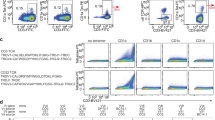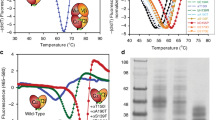Abstract
T-cell antigen receptors composed of γ and δ polypeptide chains (γδTCRs) can directly recognize antigens in the form of intact proteins or non-peptide compounds, unlike αβTCRs, which recognize antigens bound to major histocompatibility complex molecules (MHC). About 5% of peripheral blood T cells bear γδTCRs, most of which recognize non-peptide phosphorylated antigens1,2. Here we describe the 3.1 Å resolution structure of a human γδTCR from a T-cell clone3 that is phosphoantigen-reactive. The orientation of the variable (V) and constant (C) regions of the γδTCR is unique when compared with αβTCRs or antibodies, and results from an unusually small angle between the Vγ and Cγ domains. The complementarity-determining regions (CDRs) of the V domains exhibit a chemically reasonable binding site for phosphorylated antigens, providing a possible explanation for the canonical usage of the Vγ9 and Vδ2 gene segments by phosphoantigen-reactive receptors. Although the γδTCR V domains are similar in overall structure to those of αβTCRs, γδTCR C domains are markedly different. Structural differences in Cγ and Cδ, and in the location of the disulphide bond between them, may enable γδTCRs to form different recognition/signalling complexes than αβTCRs.
This is a preview of subscription content, access via your institution
Access options
Subscribe to this journal
Receive 51 print issues and online access
$199.00 per year
only $3.90 per issue
Buy this article
- Purchase on Springer Link
- Instant access to full article PDF
Prices may be subject to local taxes which are calculated during checkout




Similar content being viewed by others
References
Hayday, A. C. γδ cells: a right time and a right place for a conserved third way of protection. Annu. Rev. Immunol. 18, 975–1026 (2000).
Chien, Y. H., Jores, R. & Crowley, M. P. Recognition by γ/δ T cells. Annu. Rev. Immunol. 14, 511–532 (1996).
Constant, P. et al. Stimulation of human γδ T cells by nonpeptidic mycobacterial ligands. Science 264, 267–270 (1994).
Rock, E. P., Sibbald, P. R., Davis, M. M. & Chien, Y. H. CDR3 length in antigen-specific immune receptors. J. Exp. Med. 179, 323–328 (1994).
Sciammas, R. et al. Unique antigen recognition by a herpesvirus-specific TCR-γδ cell. J. Immunol. 152, 5392–5397 (1994).
Morita, C. T. et al. Direct presentation of nonpeptide prenyl pyrophosphate antigens to human γδ T cells. Immunity 3, 495–507 (1995).
Lang, F. et al. Early activation of human Vγ9Vδ2 T cell broad cytotoxicity and TNF production by nonpeptidic mycobacterial ligands. J. Immunol. 154, 5986–5994 (1995).
Davodeau, F. et al. Close correlation between Daudi and mycobacterial antigen recognition by human γδ T cells and expression of V9JPC1γ/V2DJCδ-encoded T cell receptors. J. Immunol. 151, 1214–1223 (1993).
Fournié, J. J. & Bonneville, M. Stimulation of γδ T cells by phosphoantigens. Res. Immunol. 147, 338–347 (1996).
Belmant, C. et al. 3-formyl-1-butyl pyrophosphate: a novel mycobacterial metabolite-activating human γδ T cells. J. Biol. Chem. 274, 32079–32084 (1999).
Tanaka, Y., Morita, C. T., Nieves, E., Brenner, M. B. & Bloom, B. R. Natural and synthetic non-peptide antigens recognized by human γδ T cells. Nature 375, 155–158 (1995).
Bukowski, J. F., Morita, C. T. & Brenner, M. B. Human γδ T cells recognize alkylamines derived from microbes, edible plants, and tea: implications for innate immunity. Immunity 11, 57–65 (1999).
Kunzmann, V. et al. Stimulation of γδ T cells by aminobisphosphonates and induction of antiplasma cell activity in multiple myeloma. Blood 96, 384–392 (2000).
Li, H. et al. Structure of the Vδ domain of a human γδ T-cell antigen receptor. Nature 391, 502–506 (1998).
Loh, E. Y. et al. Gene transfer studies of T cell receptor-γδ recognition. Specificity for staphylococcal enterotoxin A is conveyed by Vγ9 alone. J. Immunol. 152, 3324–3332 (1994).
Li, H. et al. Three-dimensional structure of the complex between a T cell receptor β chain and the superantigen staphylococcal enterotoxin B. Immunity 9, 807–816 (1998).
Morita, C. T. et al. Superantigen recognition by γδ T Cells: SEA recognition site for human Vγ2 T cell receptors. Immunity 14, 331–344 (2001).
Belmant, C. et al. A chemical basis for selective recognition of nonpeptide antigens by human γδ T cells. FASEB J. 14, 1669–1670 (2000).
Davodeau, F. et al. Peripheral selection of antigen receptor junctional features in a major human γδ subset. Eur. J. Immunol. 23, 804–808 (1993).
Panchamoorthy, G. et al. A predominance of the T cell receptor Vγ2/Vδ2 subset in human mycobacteria-responsive T cells suggests germline gene encoded recognition. J. Immunol. 147, 3360–3369 (1991).
Bentley, G. A., Boulot, G., Karjalainen, K. & Mariuzza, R. A. Crystal structure of the β chain of a T cell antigen receptor. Science 267, 1984–1987 (1995).
Wang, J. et al. Atomic structure of an αβ T cell receptor (TCR) heterodimer in complex with an anti-TCR Fab fragment derived from a mitogenic antibody. EMBO J. 17, 10–26 (1998).
Davodeau, F. et al. Secretion of disulfide-linked human T-cell receptor γδ heterodimers. J. Biol. Chem. 268, 15455–15460 (1993).
Otwinowski, Z. & Minor, W. Processing of X-ray diffraction data collected in oscillation mode. Methods Enzymol. 276, 307–326 (1997).
Smith, G. D., Nagar, B., Rini, J. M., Hauptman, H. A. & Blessing, R. H. The use of SnB to determine an anomalous scattering substructure. Acta Crystallogr. D 54, 799–804 (1998).
de la Fortelle, E. & Bricogne, G. Maximum-likelihood heavy-atom parameter refinement for multiple isomorphous replacement and multiwavelength anomalous diffraction methods. Methods Enzymol. 276, 472–494 (1997).
Bailey, S. The CCP4 suite—programs for protein crystallography. Acta Crystallogr D 50, 760–763 (1994).
Kleywegt, G. J. & Jones, T. A. in From First Map to Final Model (eds. Bailey, S., Hubbard, R. & Waller, D.) 59–66 (SERC Daresbury Laboratory, Warrington, 1994).
Jones, T. A., Zou, J. Y., Cowan, S. W. & Kjeldgaard, M. Improved methods for binding protein models in electron density maps and the location of errors in these models. Acta Crystallogr. A 47, 110–119 (1991).
Brünger, A. T. et al. Crystallography & NMR system: A new software suite for macromolecular structure determination. Acta Crystallogr. D 54, 905–921 (1998).
Acknowledgements
We thank C. Hammer for mass spectrometry; M. Garfield for amino-acid sequencing; S. Garman for advice and discussions; and Z. Dauter and K. R. Rajashankar for help at beamline X9B at the National Synchrotron Light Source at Brookhaven National Laboratory, which is supported by the US Department of Energy, Division of Materials Sciences and Division of Chemical Sciences. T.J.A. is supported by a postdoctoral fellowship from the Cancer Research Institute. This work is supported by the intramural program of the National Institute of Allergy and Infectious Diseases.
Author information
Authors and Affiliations
Corresponding author
Supplementary information

Figure S1. (GIF 38 KB)
Comparison of the four domains of G115 with an αβTCR and an Fab. The Vδ, Vβ, Cδ, and Cβ domains of G115 (in red) are superimposed on to Vα, Vβ, Cα, Cβ TCR domains (top row, in green, 1qsf) and on to VL, VH, CL, CH Fab domains (bottom row, in blue, 8fab). Differences are highlighted (bold colors). Domains were aligned using 64 V- and 50 C-domain core residues (the Cδ:Cα alignment used only 20 residues). The r.m.s. deviations (in Å) over Cα atoms for each domain-domain pair are: Vδ:Vα 0.8, Vβ:Vβ 1.1, Cδ:Cα 0.8, Cβ:Cβ 1.0 and Vδ:VL 0.7 (with VH, 0.8), Vβ:VH 0.8 (with VL, 0.8), Cδ:CL 1.0, Cβ:CH 0.9. Comparisons with other αβTCRs and Fabs are similar.

Figure S2. (GIF 48 KB)
2Fo-Fc simulated annealing omit map for the FG loop of Cβ shows strong density for the entire loop and no density for the region occupied by the FG loop of Cβ. Backbone and side-chain atoms of Cβ are colored in red and pink, respectively; backbone atoms of a superimposed Cβ domain are shown in green. The map is contoured at 1.1δ with a cover radius of 2.3 Å.
Rights and permissions
About this article
Cite this article
Allison, T., Winter, C., Fournié, JJ. et al. Structure of a human γδ T-cell antigen receptor. Nature 411, 820–824 (2001). https://doi.org/10.1038/35081115
Received:
Accepted:
Issue Date:
DOI: https://doi.org/10.1038/35081115
This article is cited by
-
Expression, Purification, and Crystallization of the Vγ9Vδ2 T-cell Receptor Recognizing Protein/Peptide Antigens
The Protein Journal (2023)
-
Identification of new potential antigen recognized by γδT cells in hepatocellular carcinoma
Cancer Immunology, Immunotherapy (2021)
-
Human γδT-cell subsets and their involvement in tumor immunity
Cellular & Molecular Immunology (2017)
-
The burgeoning family of unconventional T cells
Nature Immunology (2015)
-
Butyrophilin 3A1 presents phosphoantigens to human γδ T cells: the fourth model of antigen presentation in the immune system
Cellular & Molecular Immunology (2014)
Comments
By submitting a comment you agree to abide by our Terms and Community Guidelines. If you find something abusive or that does not comply with our terms or guidelines please flag it as inappropriate.



